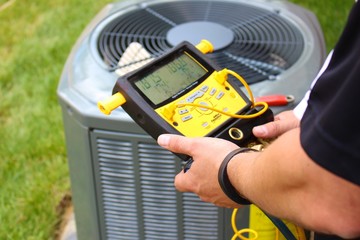When purchasing an HVAC system, homeowners are faced with a number of decisions including brands, product tiers and types of equipment. The right decision is critical to homeowner comfort and reliability.
Proper sizing and installation of HVAC Round Rock system ensures efficiency, longevity and warranty compliance. It also increases the likelihood of savings and comfort.
Heating, ventilation and air conditioning (HVAC) involves regulating the temperature of an indoor environment. It also helps improve indoor air quality through filtration and purification. It also replenishes oxygen levels to keep the environment breathable and healthy for building occupants. HVAC systems use sensors to monitor and track a variety of environmental variables, such as temperature, humidity, and airflow. These sensors send data to the controller, which makes a decision based on that information. For example, if the sensor detects that the room temperature is lower than it should be, the control system will turn on the heater.
Temperature control is essential to a wide range of applications, including industrial manufacturing processes, food processing, and HVAC systems. It ensures that heating and cooling mechanisms operate efficiently to maintain a stable indoor environment, with minimal energy consumption. A reliable temperature control system requires accurate measurements, responsive control mechanisms, and proper tuning of control parameters.
There are many different types of temperature control systems available, with a wide range of features and capabilities. These include single-loop and multi-loop control systems. Single-loop controllers have one input and one output, while multi-loop controllers can have several inputs and multiple outputs.
The most basic type of temperature control uses a set point differential and an on/off output. For example, if the target temperature is 68 degrees Fahrenheit and the actual temperature falls below that level, the control will send a signal to turn on the heater. Once the temperature reaches 68 degrees, the controller will shut off the heater.
In more advanced systems, the output is proportionally turned on and off in relation to the measurement deviation from the setpoint. This method is known as proportional control and allows for a more precise control of the process.
In addition to temperature control, some HVAC systems have an economizer mode that can save on energy costs. This feature compares the temperature of outside air to the demand for cooling and opens (fully or partially) the supply air damper in order to bring in fresh, cool outdoor air when the air in the ducts is warmer than that demanded. This can significantly reduce the need to use mechanical refrigeration for cooling, resulting in substantial energy savings.
Humidity Control
A building’s air conditioning system can do more than just regulate temperature; it can also control indoor humidity. High humidity levels can make air feel warmer than it actually is and can cause discomfort for occupants, promote moisture and mold growth, and damage products and furniture. Conversely, low humidity can create the feeling that the space is colder than it actually is and can lead to dry skin and discomfort.
Most HVAC systems dehumidify the air during cooling periods, as they run their compressors and the evaporator coil cools and condenses water in the air. However, during non-cooling periods (and especially when the air is still heated by occupants and ventilation) the humidity level may remain high or even rise to unsatisfactory levels.
Air filters can play a big role in controlling indoor humidity levels. They filter out dust and debris from the air, which prevents it from becoming saturated with moisture and creating a damp environment. Keeping the filters clean by changing or replacing them regularly can help to improve indoor air quality, reduce dust mite and other allergen buildup, increase energy efficiency, and keep humidity at an optimal level.
In addition to keeping the air filter clean, it’s important that you have a hygrometer in your building. These devices can monitor the relative humidity of the air and alert you when a problem arises. They can also provide recommendations for improving air distribution, which can be a major contributor to humidity problems in buildings.
High humidity levels can contribute to the development of bacteria and fungi that can cause illness for occupants, as well as mold that can harm building materials and promote rot. It can also encourage the growth of insects like termites and cockroaches that can damage the building and create an unhealthy environment for the occupants.
An HVAC professional can check and adjust settings to manage indoor humidity, including adjusting the air conditioner’s fan speed. In addition, they can look for signs of other issues that can affect humidity, such as poorly matched ductwork and ventilation units or a lack of adequate duct sealing and insulation.
Air Filtration
Air filters act as a physical barrier that traps and holds particulates and contaminants before they can circulate throughout your home. These include dust, dander, dirt, mold spores, hair, fibers, and more. By preventing these particles from recirculating in your home, they can help minimize allergies and respiratory conditions. In addition, they can prevent these particles from damaging or clogging your HVAC system.
Air filtration systems come in a variety of designs and efficiency ratings. Most types are mechanical, but there are a few that use advanced chemistry to clean your air even further. These units are called scrubbers, and they can be either dry or wet. Dry scrubbers use a series of sorbent materials like activated carbon to filter out gasses, vapors, and organic chemicals from the air. They can also remove harmful bacteria and viruses from the air.
Wet scrubbers use a similar process to filter out contaminants but can also eliminate fungus and microorganisms that can cause illness. In addition, they can sanitize your ductwork and reduce the risk of fungal growth in your indoor environment.
The type of filter you select for your HVAC system will depend on your specific needs, budget, and the type of equipment in your home. The most common filters are made of spun fiberglass, and they can effectively stop large debris from entering your equipment. However, they may not catch smaller pollutants, such as bacteria or viruses. They also tend to restrict airflow and force your equipment to work harder, shortening its lifespan.
Filters with a higher MERV rating are usually more effective at trapping small pollutants, and they can improve your home’s air quality significantly. They may cost more than traditional fiberglass filters, but they can be an affordable long-term investment. You’ll need to vacuum or wash them regularly to keep them clean, and they may need to be replaced every three to 12 months depending on the thickness of the filter.
Another option is a washable filter, which can be an excellent choice for a single-zone or multi-zone ductless system. These filters should be vacuumed or washed as directed by the unit’s owner’s manual to avoid clogging or reducing airflow. You can also sign up for a filter subscription service to ensure you always have a fresh new filter on hand.
Ventilation
A big part of HVAC (Heating, Ventilation and Air Conditioning) involves ventilation. This is the process of changing or replacing air to control temperature, remove moisture, odors, smoke, dust, and airborne bacteria and to replenish oxygen. Ventilation is accomplished via mechanical or natural systems and it is one of the most important components of a HVAC system for healthy building conditions.
The most common way to control ventilation is with a mechanical system. This uses a network of air ducts and air vents to move conditioned, or heated or cooled, air through the living spaces in your home. Regular inspections of air ducts and vents are critical to ensure that they do not leak and to detect and address rodent infestation and deterioration.
Air comes into the HVAC system from outside through an air inlet unit, or air handler. From there it goes through a filter to remove particles of dirt, dander, and allergens. It is then warmed or cooled, depending on the season, and pushed through return ducts and out supply vents to living spaces. It is also possible to install humidifiers as an add-on to an HVAC system which changes indoor humidity levels.
As buildings become more tightly sealed, mechanical ventilation becomes increasingly important for maintaining healthy indoor air quality. In addition to the air filtration and temperature control, mechanical ventilation helps expels excess moisture, volatile organic compounds (VOCs), and odors from the building.
VOCs are typically emitted from chemicals such as glues and paints, and can be controlled by the use of carbon filters. In specialized systems, permanganate oxidizers can be used to control odors and gases from the HVAC system.
Ventilation is so vital that ASHRAE publishes detailed standards for ventilation requirements in buildings to maintain acceptable indoor air quality. ASHRAE also specifies that schools should have a minimum ventilation rate of 15 cubic feet per minute (cfm) of outdoor air per person. This can be achieved with energy recovery ventilation equipment that makes it cost-competitive with traditional ventilation designs, with the additional benefit of high energy efficiency and superior IAQ.



